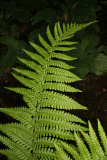Additional notes (click to expand)
Medicinal
Previously used as a treatment for tapeworm. No longer used due to toxic side effects.
Podlech, D. (1996). Herbs & Healing Plants of Britain & Europe, Collins p.196
Phytochemistry
Active ingredients = Phloroglucine derivatives, tanins, bitters.
Podlech, D. (1996). Herbs & Healing Plants of Britain & Europe, Collins p.196
Toxicity
Neurogenic Vision Loss
Plant Toxicities
"In England, ingestion of the rhizomes of male fern (Dryopteris filix-mas) by cattle has been associated with permanent or, more frequently, transient blindness. Blindness may be the primary presenting sign, although drowsiness, weakness, malaise, and constipation also occur. Retinal ganglion cells and optic nerve fibers are destroyed, and on ophthalmoscopy, variable amounts of papilledema and peripapillary hemorrhages are observed initially (thus necessitating differentiation from hypovitaminosis A). In advanced cases, optic nerve head atrophy and retinal vascular attenuation are noted" [Paul Miller].
Paul E. Miller, in Food Animal Practice (Fifth Edition), 2009 https://www.sciencedirect.com/topics/agricultural-and-biological-sciences/dryopteris-filix-mas
Toxic due to presence of phloroglucinol. Severe effects in humans and domestic animals after swallowing
Professor Anthony Dayan, 2022
Geographical distribution
- Africa, Northern Africa, Morocco
- Asia-Temperate, Caucasus, Transcaucasus
- Asia-Temperate, Middle Asia, Kazakhstan
- Asia-Temperate, Middle Asia, Tadzhikistan
- Asia-Temperate, Middle Asia, Turkmenistan
- Asia-Temperate, Russian Far East
- Asia-Temperate, Siberia, West Siberia
- Asia-Temperate, Western Asia, Turkey
- Europe, Eastern Europe, Baltic States
- Europe, Eastern Europe, Belarus
- Europe, Eastern Europe, North European Russia
- Europe, Eastern Europe, Northwest European Russia
- Europe, Eastern Europe, South European Russia
- Europe, Eastern Europe, Ukraine
- Europe, Middle Europe, Austria
- Europe, Middle Europe, Belgium
- Europe, Middle Europe, Germany
- Europe, Middle Europe, Hungary
- Europe, Middle Europe, Netherlands
- Europe, Middle Europe, Poland
- Europe, Middle Europe, Slovakia
- Europe, Middle Europe, Switzerland
- Europe, Northern Europe, Denmark
- Europe, Northern Europe, Great Britain
- Europe, Northern Europe, Iceland
- Europe, Northern Europe, Ireland
- Europe, Northern Europe, Norway
- Europe, Northern Europe, Sweden
- Europe, Southeastern Europe, Albania
- Europe, Southeastern Europe, Bosnia and Herzegovina
- Europe, Southeastern Europe, Bulgaria
- Europe, Southeastern Europe, Czech Republic
- Europe, Southeastern Europe, Greece
- Europe, Southeastern Europe, Italy
- Europe, Southeastern Europe, Romania
- Europe, Southeastern Europe, Yugoslavia
- Europe, Southwestern Europe, France
- Europe, Southwestern Europe, Portugal
- Europe, Southwestern Europe, Spain
- Northern America, Eastern Canada
- Northern America, North-Central U.S.A.
- Northern America, Northeastern U.S.A.
- Northern America, Northwestern U.S.A.
- Northern America, South-Central U.S.A.
- Northern America, Southeastern U.S.A.
- Northern America, Southwestern U.S.A.
- Northern America, Western Canada
Dryopteris filix-mas (L.) Schott
Family: POLYPODIACEAEGenus: Dryopteris
Species: filix-mas (L.) Schott
Common names: Male fern
Pharmacopoeia Londinensis name: Filix
Distribution summary: N. Africa, Eurasia, N. America
Habit: Perennial
Hardiness: H5 - Hardy; cold winter
Habitat: Woods, banks, ditches, mountains
Garden status: Currently grown
Garden location: Plants of the World (C)
Flowering months: July, August, September
Reason for growing: Medicinal, toxic
